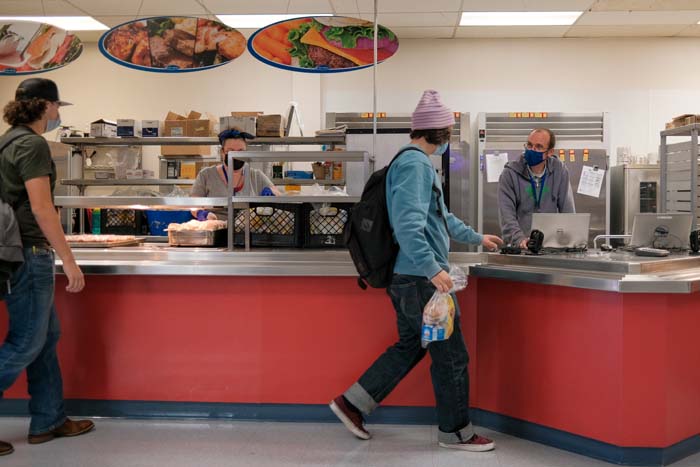Many families may have to pay for school lunches again next year
Published 7:00 am Thursday, May 5, 2022

- Austin Hawks, a paraeducator, helps students as they receive their free lunches at La Grande High School on Tuesday, Oct. 19, 2021. One proposal by lawmakers and advocates would expand the free meals program in Oregon to more schools.
UNION COUNTY — Fewer children in Union County may be eating lunches and breakfasts served at their public schools next fall.
Trending
There is a strong possibility the federal government’s universal free lunch program, which allowed all public school students to eat school meals at no cost the past two years due to the COVID-19 pandemic, will expire in June. This would mean many students attending Union County public schools will again be charged for school lunches and breakfasts.
“My guess is that this will cut back on the number of our students eating school lunches. We had a lot more students eating lunches when they were free,” said Imbler School District Superintendent Doug Hislop.
The universal free lunch program was put in place in March 2020 to give school districts more flexibility and support as they tackled challenges posed by the COVID-19 pandemic, which is now dramatically subsiding.
Trending
The funding needed for the continuation of the universal free meals program is not included in Congress’ proposed 2022-23 federal budget.
Free and reduced cost meals will remain for qualifying students
The good news is that funding is in the budget to allow students from low-income families to continue receiving free lunches and breakfasts and for others from households with slightly higher incomes to receive reduced price meals.
Hislop is worried that not all students from lower-income families will take advantage of the free and reduced price lunch option, the same one in place long before COVID-19 hit. The reason is families have to fill out applications for free and reduced cost lunches, which require them to reveal their household income.
Some families will not apply because they do not want others to know their economic status, Hislop said. This is unfortunate since there is no reason to be concerned about private information getting out, the superintendent said. He explained that only one person, a school district employee, ever sees the Imbler applications and the names of applicants are never shared with anyone. Income data is sent to the federal government but not the names of the families it applies to.
“My concern is that we will have kids who qualify but because their parents are reluctant to apply the children will go hungry,” Hislop said.
Union School District Superintendent Carter Wells agrees that it is hard to get some families to fill out applications for free and reduced price lunches for their children.
“People are very prideful and there is some delicate information they are asked,” Wells said.
The Union superintendent said he tries to tactfully get families to complete the applications.
“I encourage them to step out of their comfort zone and fill them out,” he said.
Nutritious meals fuel learning
Wells said it is critical that students eat nutritious meals when they are in school.
“A student who is hungry cannot focus on what is being presented in the classroom,” Wells said.
He said if students are for some reason not able to buy school lunch or bring their lunches to school after this academic year, the Union School District’s staff will step forward to assist.
“We will do everything we can to get properly cooked meals in front of students,” Wells said.
Helping school districts get funding
Families who submit completed applications for free and reduced price lunches and breakfasts are helping not only their children but also their school districts.
Hislop explained that the amount of federal money school districts are eligible to receive for academic programs is determined in part by the percentage of students who are from families that qualify for free and reduced price lunches.
Lunches will stay free in La Grande School District
The looming expiration of the universal free lunch program will have no impact on the La Grande School District where free lunches and breakfasts will continue to be available to all students, according to Michelle Glover, the La Grande School District’s budget director. The reason, she said, is that the school district is part of the Community Eligibility Provision program and will remain so at least through the 2024-25 school year.
The Community Eligibility Provision is a non-pricing meal service option for schools and school districts in low-income areas. CEP allows schools and districts to serve breakfast and lunch at no cost to all enrolled students without collecting household applications, Glover said. Instead, schools that adopt CEP are reimbursed using a formula supported by the percentage of students eligible for free meals based on their participation in other specific means-tested programs, such as the Supplemental Nutrition Assistance Program and Temporary Assistance for Needy Families, according to Glover.
Converting brown baggers
Cove School District Superintendent Earl Pettit said that there may be a small drop in the number of students eating meals served by his school district. However, he also thinks the number of students eating school lunches may be higher than before the pandemic. Pettit explained this may occur because a number of students who had brought sack lunches to school before the pandemic began eating the free midday meals served at school after the pandemic began.
“They started eating lunch at school and liked it. It was a culture change. They got used to it after packing lunches to school,” Pettit said.
The Cove superintendent is glad the federal government provided free school lunches to students because it reduced the red tape they had to deal with during the pandemic.
“It was a good decision,” Pettit said.
Mark Mulvihill, superintendent of the InterMountain Education Service District, which serves Union, Umatilla and Morrow counties, also said the government’s decision to provide free meals during the pandemic was a big plus.
“It was a key part of the COVID-19 recovery,” Muvihill said. “It stabilized families.”









